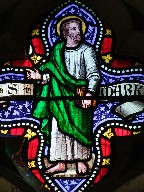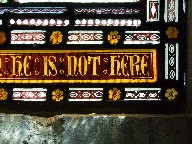| |
|
 |
|
Woodland on the
edge of heathland; now the quietest part
of Suffolk, this was once the most
populous area in England. Here came the
Angles and the Frisians, the Saxons and
the Jutes, quietly and industriously up
the estuaries and river valleys,
reclaiming the land the Romans had
abandoned, clearing acres of forest and
bringing them under cultivation, settling
down. And we're still here, of course.
But this part of Suffolk now is one of
tiny villages, and many redundant
churches. St Mary is not redundant, but I
didn't see a single soul on my journey
across its parish. Incidentally, it wasn't the
size of the population which gave East
Anglia so many parishes, and so many
parish churches. It was a result of the
Anglo-Saxon manorial system. Because
Norfolk, Suffolk and Essex were the first
places to be settled, the manors tended
to be very small, crowding together on
river banks and in forest clearings. Each
manor had its own church. The parishes
were based on the manors, and although
virtually nothing survives of the Saxon
buildings, the parishes themselves
survive and in most cases the churches we
see today were built on the sites of
Saxon predecessors. You don't have to go
far to see what those Saxon villages were
like, for not far from this church is
West Stow Anglo-Saxon Village, a
reconstruction which is regularly
populated by Anglo-Saxon characters going
about their Anglo-Saxon activities on
open days. It's well worth a visit.
|
St Mary sits in a wide
graveyard, the outer edges wild, and merging into
the forest. It was as if this was a
clearing that some 7th Century Angle had hacked
out and made safe for theocracy - and perhaps it
is. Rabbits scampered away as I approached,
leaving me to birdsong and the silence of the
graves. You approach the large, ship-like church
from the east, and it unfolds before you, leading
you to its blockish 14th Century tower. This
largely 14th and 15th century church was mostly
derelict by the early 19th century, as so many
were around here. The Victorians stepped in and
saved it.
When I first came this way
in the 1990s, the church was kept locked without
a keyholder notice, but now you can pick one up
from the nice people across the road. You let
yourself in to what is above all else a 19th
Century interior, but a pleasantly rustic one.
You can imagine West Stow's shepherds and
ploughmen shuffling uncomfortably on the benches
in the last years of the old queen's reign. The
keyring also has the key to the vestry, and if
you open the door you can look back at the oldest
part of the building, the very early Norman north
doorway which was already half a millennium old
by the time of the Reformation. It is similar to
the one across the fields at Wordwell.
At the other end of the
Middle Ages is the church's great other medieval
survival, the canopied and cusped piscina in the
sanctuary. The sill to the west of it is all that
survives of what was probably a matching sedilia.
The 19th Century communion rail is pleasingly
carved. The glass to north and south unusually
depicts scenes of people being brought back to
life: Peter raises Tabitha from the dead, Paul
raises Eutychus, Christ raises Lazarus and in the
final scene the three Marys are greeted by the
angel at the empty tomb. Old Testament characters
appear in vignettes in the upper lights. In the
East Window, Christ performs miracles.
| In the 1930s,
Cautley traced St Mary's rood screen dado
to the reserve collection of the Victoria
and Albert Museum in London. It was
donated, presumably after the 19th
century restoration, as an exemplar of
East Anglian rood screen woodwork.
Unusually for Cautley, he didn't march in
with guns blazing, retrieve it, and force
the churchwardens to reinstall it (or
perhaps he tried to, and the museum
wouldn't let him have it). This is a
pity, because it would have made a
welcome addition to a church which is not
dull but lacks a real sense of the
numinous. A
late 16th Century brass inscription by
the pulpit remembers Rector William
Boyce: His heart stopped, and now the
grave holds his body and Christ his soul.
|
|
 |
|
|
|

